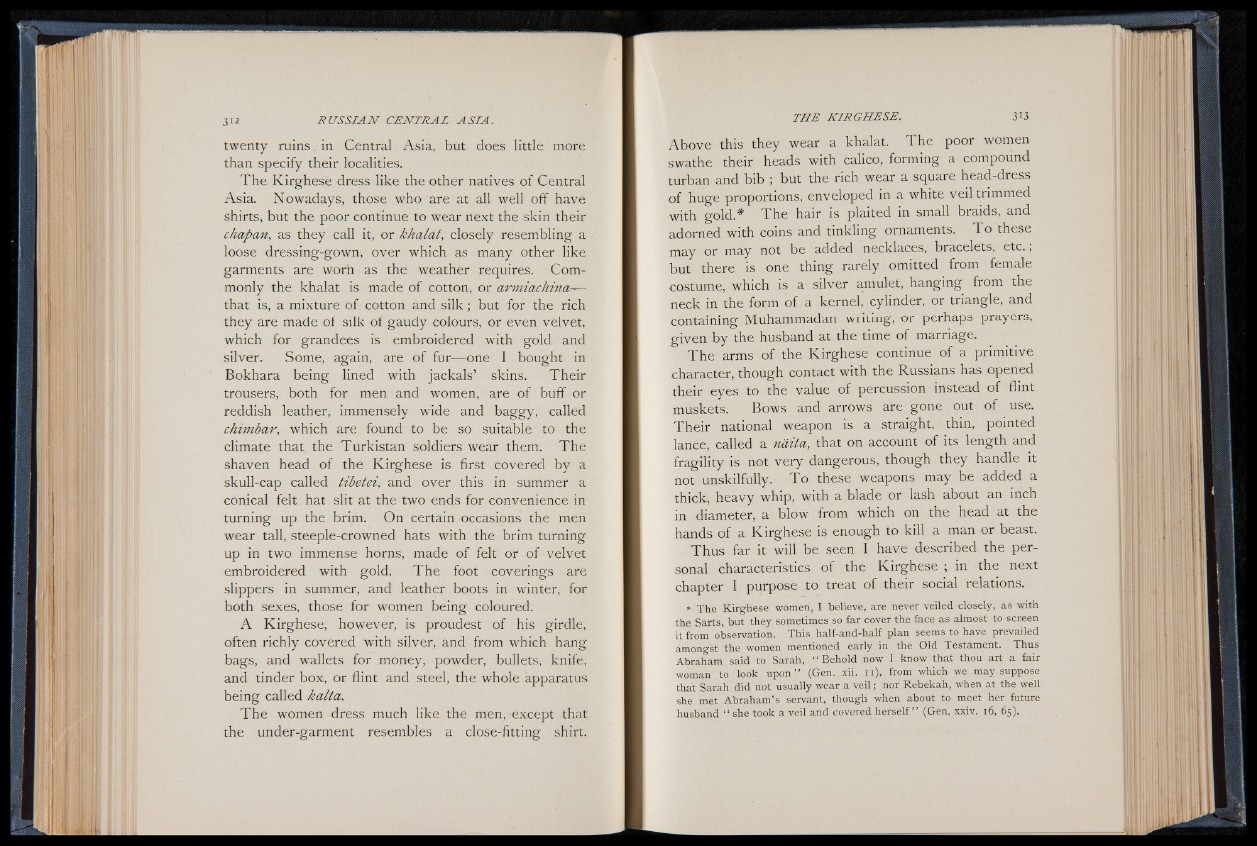
twenty ruins in Central Asia, but does little more
than specify their localities.
The Kirghese dress like the other natives of Central
Asia. Nowadays, those who are at all well off have
shirts, but the poor continue to wear next the skin their
chapan, as they call it, or khalat, closely resembling a
loose dressing-gown, over which as many other like
garments are worn as the weather requires. Commonly
the khalat is made of cotton, or armiachina—
that is, a mixture of cotton and silk ; but for the rich
they are made of silk of gaudy colours, or even velvet,
which for grandees is embroidered with gold and
silver. Some, again, are of fur— one I bought in
Bokhara being lined with jackals’ skins. Their
trousers, both for men and women, are of buff or
reddish leather, immensely wide and baggy, called
chimbar, which are found to be so suitable to the
climate that the Turkistan soldiers wear them. The
shaven head of the Kirghese is first covered by a
skull-cap called tibetei, and over this in summer a
conical felt hat slit at the two ends for convenience in
turning up the brim. On certain occasions the men
wear tall, steeple-crowned hats with the brim turning
up in two immense horns, made of felt or of velvet
embroidered with gold. The foot coverings are
slippers in summer, and leather boots in winter, for
both sexes, those for women being coloured.
A Kirghese, however, is proudest of his girdle,
often richly covered with silver, and from which hang
bags, and wallets for money, powder, bullets, knife,
and tinder box, or flint and steel, the whole apparatus
being called kalta.
The women dress much like the men, except that
the under-garment resembles a close-fitting shirt.
Above this they wear a khalat. The poor women
swathe their heads with calico, forming a compound
turban and bib ; but the rich wear a square head-dress
of huge proportions, enveloped in a white veil trimmed
with gold.* The hair is plaited in small braids, and
adorned with coins and tinkling ornaments. T o these
may or may not be added necklaces, bracelets, e tc .,
but there is one thing rarely omitted from female
costume, which is a silver amulet, hanging from the
neck in the form of a kernel, cylinder, or triangle, and
containing Muhammadan writing, or perhaps prayers,
given by the husband at the time of marriage.
The arms of the Kirghese continue of a primitive
character, though contact with the Russians has opened
their eyes to the value of percussion instead of flint
muskets. Bows and arrows are gone out of use.
Their national weapon is a straight, thin, pointed
lance, called a naita, that on account of its length and
fragility is not very dangerous, though they handle it
not unskilfully. T o these weapons may be added a
thick, heavy whip, with a blade or lash about an inch
in diameter, a blow from which on the head at the
hands of a Kirghese is enough to kill a man or beast.
Thus far it will be seen I have described the personal
characteristics of the Kirghese ; in the next
chapter I purpose to treat of their social relations.
* The Kirghese women, I believe, are never veiled closely, as with
the Sarts, but they sometimes so far cover the face as almost to screen
it from observation. This half-and-half plan seems to have prevailed
amongst the women mentioned early in the Old Testament. Thus
Abraham said to Sarah, “ Behold now I know that thou art a fair
woman to look u p on ” (Gen. xii. 11), from which we may suppose
that Sarah did not usually wear a v e i l; nor Rebekah, when at the well
she met Abraham’ s servant, though when about to meet her future
husband 1 she took a veil and covered herself ’ ’ (Gen. xxiv. 16, 65).